Alexandra Luccioni
Geo-Spatiotemporal Features and Shape-Based Prior Knowledge for Fine-grained Imbalanced Data Classification
Mar 21, 2021
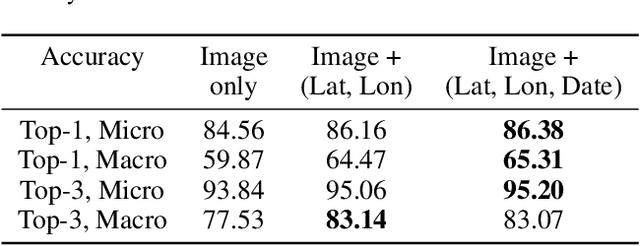

Abstract:Fine-grained classification aims at distinguishing between items with similar global perception and patterns, but that differ by minute details. Our primary challenges come from both small inter-class variations and large intra-class variations. In this article, we propose to combine several innovations to improve fine-grained classification within the use-case of wildlife, which is of practical interest for experts. We utilize geo-spatiotemporal data to enrich the picture information and further improve the performance. We also investigate state-of-the-art methods for handling the imbalanced data issue.
* Copyright by the authors. All rights reserved to authors only. Correspondence to: ckantor (at) stanford [dot] edu
Analyzing Sustainability Reports Using Natural Language Processing
Nov 03, 2020


Abstract:Climate change is a far-reaching, global phenomenon that will impact many aspects of our society, including the global stock market \cite{dietz2016climate}. In recent years, companies have increasingly been aiming to both mitigate their environmental impact and adapt to the changing climate context. This is reported via increasingly exhaustive reports, which cover many types of climate risks and exposures under the umbrella of Environmental, Social, and Governance (ESG). However, given this abundance of data, sustainability analysts are obliged to comb through hundreds of pages of reports in order to find relevant information. We leveraged recent progress in Natural Language Processing (NLP) to create a custom model, ClimateQA, which allows the analysis of financial reports in order to identify climate-relevant sections based on a question answering approach. We present this tool and the methodology that we used to develop it in the present article.
Considerations, Good Practices, Risks and Pitfalls in Developing AI Solutions Against COVID-19
Aug 13, 2020
Abstract:The COVID-19 pandemic has been a major challenge to humanity, with 12.7 million confirmed cases as of July 13th, 2020 [1]. In previous work, we described how Artificial Intelligence can be used to tackle the pandemic with applications at the molecular, clinical, and societal scales [2]. In the present follow-up article, we review these three research directions, and assess the level of maturity and feasibility of the approaches used, as well as their potential for operationalization. We also summarize some commonly encountered risks and practical pitfalls, as well as guidelines and best practices for formulating and deploying AI applications at different scales.
* 4 pages, 1 figure
Mapping the Landscape of Artificial Intelligence Applications against COVID-19
Apr 23, 2020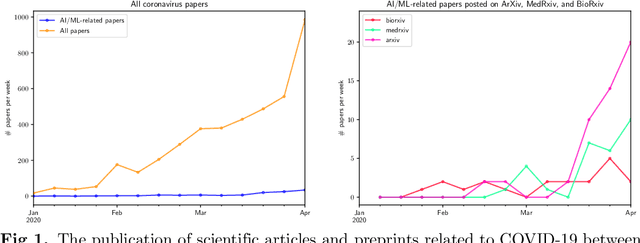
Abstract:COVID-19, the disease caused by the SARS-CoV-2 virus, has been declared a pandemic by the World Health Organization, with over 2.5 million confirmed cases as of April 23, 2020. In this review, we present an overview of recent studies using Machine Learning and, more broadly, Artificial Intelligence, to tackle many aspects of the COVID-19 crisis at different scales including molecular, clinical, and societal applications. We also review datasets, tools, and resources needed to facilitate AI research. Finally, we discuss strategic considerations related to the operational implementation of projects, multidisciplinary partnerships, and open science. We highlight the need for international cooperation to maximize the potential of AI in this and future pandemics.
Using Simulated Data to Generate Images of Climate Change
Jan 26, 2020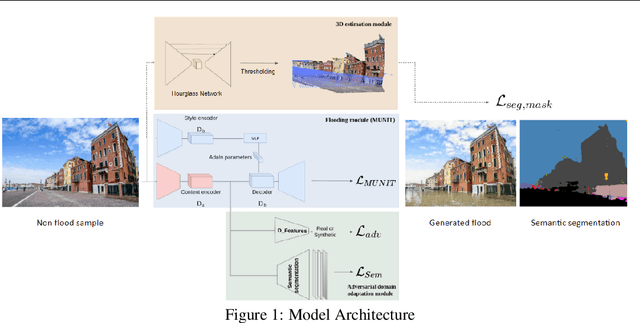
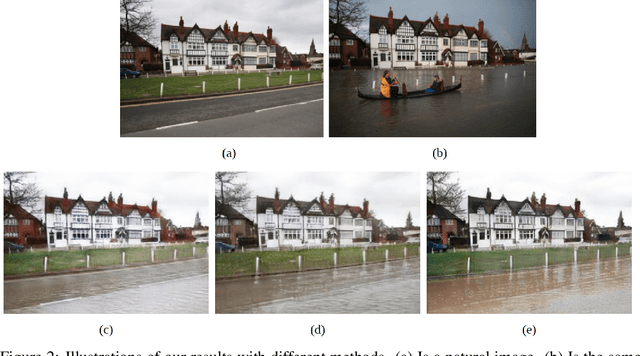
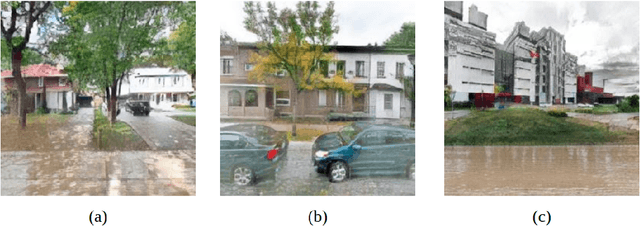

Abstract:Generative adversarial networks (GANs) used in domain adaptation tasks have the ability to generate images that are both realistic and personalized, transforming an input image while maintaining its identifiable characteristics. However, they often require a large quantity of training data to produce high-quality images in a robust way, which limits their usability in cases when access to data is limited. In our paper, we explore the potential of using images from a simulated 3D environment to improve a domain adaptation task carried out by the MUNIT architecture, aiming to use the resulting images to raise awareness of the potential future impacts of climate change.
On the Morality of Artificial Intelligence
Dec 26, 2019Abstract:Much of the existing research on the social and ethical impact of Artificial Intelligence has been focused on defining ethical principles and guidelines surrounding Machine Learning (ML) and other Artificial Intelligence (AI) algorithms [IEEE, 2017, Jobin et al., 2019]. While this is extremely useful for helping define the appropriate social norms of AI, we believe that it is equally important to discuss both the potential and risks of ML and to inspire the community to use ML for beneficial objectives. In the present article, which is specifically aimed at ML practitioners, we thus focus more on the latter, carrying out an overview of existing high-level ethical frameworks and guidelines, but above all proposing both conceptual and practical principles and guidelines for ML research and deployment, insisting on concrete actions that can be taken by practitioners to pursue a more ethical and moral practice of ML aimed at using AI for social good.
Quantifying the Carbon Emissions of Machine Learning
Nov 04, 2019
Abstract:From an environmental standpoint, there are a few crucial aspects of training a neural network that have a major impact on the quantity of carbon that it emits. These factors include: the location of the server used for training and the energy grid that it uses, the length of the training procedure, and even the make and model of hardware on which the training takes place. In order to approximate these emissions, we present our Machine Learning Emissions Calculator, a tool for our community to better understand the environmental impact of training ML models. We accompany this tool with an explanation of the factors cited above, as well as concrete actions that individual practitioners and organizations can take to mitigate their carbon emissions.
Establishing an Evaluation Metric to Quantify Climate Change Image Realism
Oct 22, 2019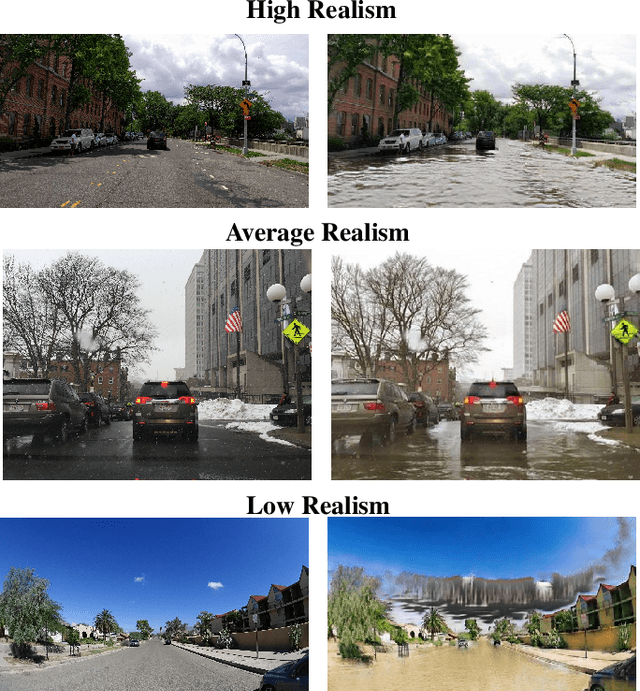

Abstract:With success on controlled tasks, generative models are being increasingly applied to humanitarian applications [1,2]. In this paper, we focus on the evaluation of a conditional generative model that illustrates the consequences of climate change-induced flooding to encourage public interest and awareness on the issue. Because metrics for comparing the realism of different modes in a conditional generative model do not exist, we propose several automated and human-based methods for evaluation. To do this, we adapt several existing metrics, and assess the automated metrics against gold standard human evaluation. We find that using Fr\'echet Inception Distance (FID) with embeddings from an intermediary Inception-V3 layer that precedes the auxiliary classifier produces results most correlated with human realism. While insufficient alone to establish a human-correlated automatic evaluation metric, we believe this work begins to bridge the gap between human and automated generative evaluation procedures.
Tackling Climate Change with Machine Learning
Jun 10, 2019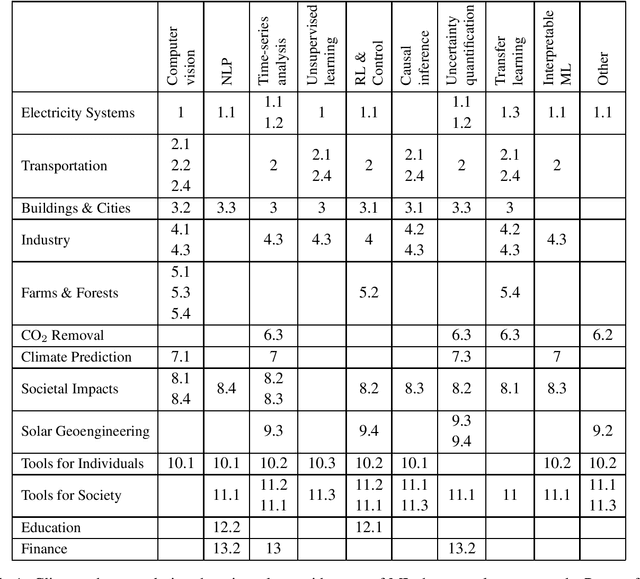
Abstract:Climate change is one of the greatest challenges facing humanity, and we, as machine learning experts, may wonder how we can help. Here we describe how machine learning can be a powerful tool in reducing greenhouse gas emissions and helping society adapt to a changing climate. From smart grids to disaster management, we identify high impact problems where existing gaps can be filled by machine learning, in collaboration with other fields. Our recommendations encompass exciting research questions as well as promising business opportunities. We call on the machine learning community to join the global effort against climate change.
Visualizing the Consequences of Climate Change Using Cycle-Consistent Adversarial Networks
May 02, 2019

Abstract:We present a project that aims to generate images that depict accurate, vivid, and personalized outcomes of climate change using Cycle-Consistent Adversarial Networks (CycleGANs). By training our CycleGAN model on street-view images of houses before and after extreme weather events (e.g. floods, forest fires, etc.), we learn a mapping that can then be applied to images of locations that have not yet experienced these events. This visual transformation is paired with climate model predictions to assess likelihood and type of climate-related events in the long term (50 years) in order to bring the future closer in the viewers mind. The eventual goal of our project is to enable individuals to make more informed choices about their climate future by creating a more visceral understanding of the effects of climate change, while maintaining scientific credibility by drawing on climate model projections.
 Add to Chrome
Add to Chrome Add to Firefox
Add to Firefox Add to Edge
Add to Edge